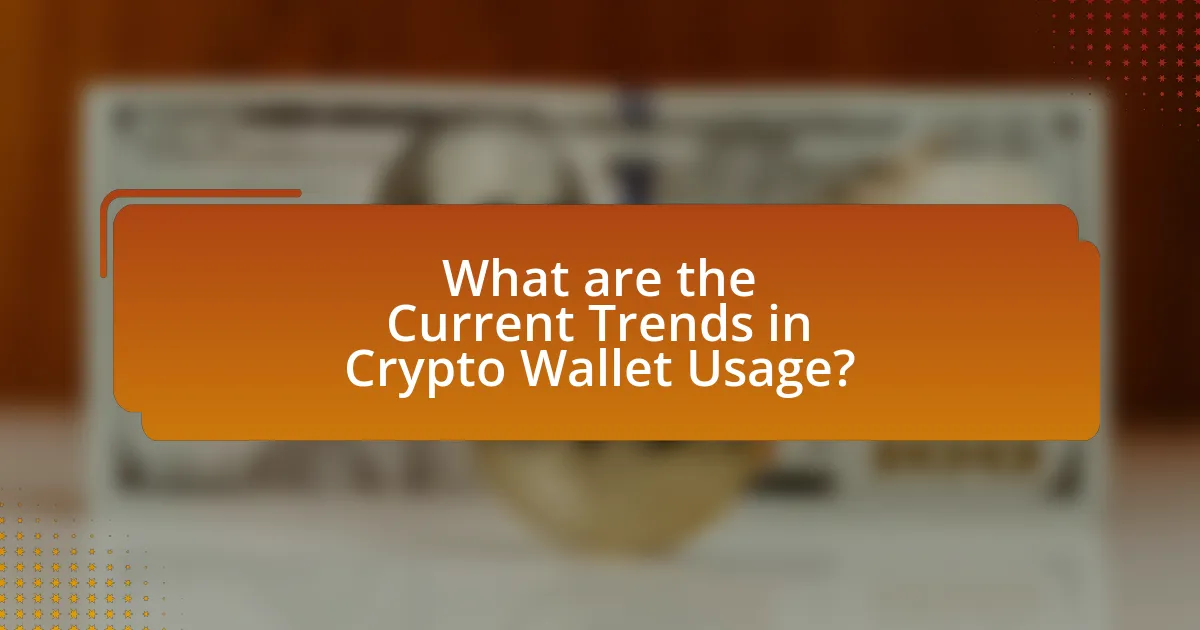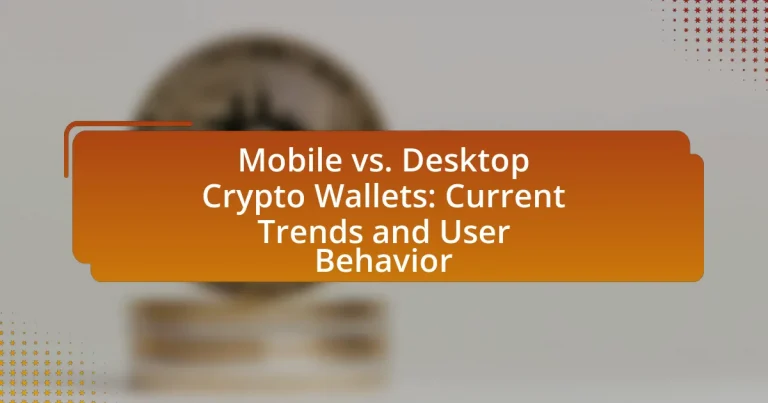Mobile and desktop crypto wallets are essential software applications for storing, managing, and transacting cryptocurrencies. The article examines the functionality, security features, and user preferences associated with both wallet types, highlighting the growing trend towards mobile wallets, which now account for over 60% of transactions. It discusses the factors driving this shift, including convenience and enhanced security measures, as well as user demographics that influence wallet choice. Additionally, the article explores emerging technologies impacting wallet usage and best practices for selecting secure wallets, providing a comprehensive overview of current trends and user behaviors in the cryptocurrency space.

What are Mobile and Desktop Crypto Wallets?
Mobile and desktop crypto wallets are software applications that allow users to store, manage, and transact cryptocurrencies. Mobile wallets are designed for use on smartphones and tablets, providing convenience and accessibility for on-the-go transactions. In contrast, desktop wallets are installed on personal computers, offering enhanced security features and a more comprehensive interface for managing larger amounts of cryptocurrency. According to a report by Statista, as of 2021, mobile wallets accounted for approximately 40% of all cryptocurrency wallet usage, highlighting their growing popularity among users seeking flexibility and ease of access.
How do Mobile Crypto Wallets function?
Mobile crypto wallets function by securely storing users’ private keys and enabling transactions through a mobile application. These wallets connect to blockchain networks, allowing users to send, receive, and manage cryptocurrencies directly from their smartphones. They utilize encryption and often require biometric authentication or PIN codes to enhance security. According to a report by Statista, as of 2023, mobile wallets accounted for over 50% of all cryptocurrency transactions, highlighting their growing importance in the digital currency ecosystem.
What features distinguish Mobile Crypto Wallets from other types?
Mobile crypto wallets are distinguished from other types by their portability, user-friendly interfaces, and integration with mobile device features such as cameras and biometric authentication. These wallets allow users to easily send and receive cryptocurrencies on-the-go, leveraging mobile connectivity for real-time transactions. Additionally, mobile wallets often support QR code scanning for quick payments and may offer enhanced security features like fingerprint or facial recognition, which are less common in desktop wallets. The convenience of accessing funds anytime and anywhere, combined with these unique functionalities, makes mobile crypto wallets particularly appealing to users seeking flexibility and ease of use in managing their digital assets.
What security measures are typically implemented in Mobile Crypto Wallets?
Mobile crypto wallets typically implement security measures such as encryption, two-factor authentication (2FA), biometric authentication, and backup recovery phrases. Encryption protects user data and transaction information, ensuring that only authorized users can access their wallets. Two-factor authentication adds an extra layer of security by requiring a second form of verification, such as a text message code or authentication app. Biometric authentication, like fingerprint or facial recognition, enhances security by using unique physical traits for access. Backup recovery phrases allow users to restore their wallets in case of device loss or failure, ensuring that funds remain secure. These measures collectively enhance the overall security of mobile crypto wallets, making them safer for users.
How do Desktop Crypto Wallets operate?
Desktop crypto wallets operate by storing private keys on a user’s computer, allowing for secure management of cryptocurrencies. These wallets generate and store the user’s private and public keys locally, enabling transactions without relying on third-party services. When a user initiates a transaction, the wallet software signs it with the private key, ensuring that only the owner can authorize the transfer of funds. This method enhances security, as the keys are not exposed to the internet, reducing the risk of hacking. According to a report by the Cambridge Centre for Alternative Finance, desktop wallets are favored for their control and security features, appealing to users who prioritize safeguarding their digital assets.
What are the key characteristics of Desktop Crypto Wallets?
Desktop crypto wallets are software applications installed on a personal computer that allow users to store, manage, and transact cryptocurrencies securely. Key characteristics include enhanced security features, such as private key storage on the user’s device, which reduces the risk of online hacks compared to web-based wallets. Additionally, desktop wallets often provide a user-friendly interface, enabling easy navigation and management of multiple cryptocurrencies. They also support advanced functionalities like transaction history tracking and integration with hardware wallets for added security. According to a report by Statista, desktop wallets account for a significant portion of the crypto wallet market, highlighting their popularity among users seeking robust security and control over their digital assets.
How do Desktop Crypto Wallets ensure user security?
Desktop crypto wallets ensure user security primarily through encryption, private key management, and secure backup options. These wallets encrypt user data and private keys, making it difficult for unauthorized parties to access sensitive information. Additionally, they often allow users to generate and store private keys locally on their devices, reducing the risk of exposure to online threats. Many desktop wallets also provide features such as two-factor authentication and recovery seed phrases, which further enhance security by requiring multiple forms of verification for access. These measures collectively create a robust security framework that protects users’ digital assets from theft and unauthorized access.

What are the Current Trends in Crypto Wallet Usage?
Current trends in crypto wallet usage indicate a significant shift towards mobile wallets, driven by increased smartphone adoption and the demand for convenience. According to a report by Statista, as of 2023, mobile wallets account for over 60% of all crypto wallet transactions, reflecting user preference for accessibility and ease of use. Additionally, the rise of decentralized finance (DeFi) has led to a growing interest in non-custodial wallets, which allow users to maintain control over their private keys. This trend is supported by data from Chainalysis, which shows a 40% increase in the use of non-custodial wallets in the past year. Furthermore, security features such as biometric authentication and multi-signature capabilities are becoming standard in mobile wallets, enhancing user trust and adoption rates.
How has the popularity of Mobile vs. Desktop Crypto Wallets changed over time?
The popularity of mobile crypto wallets has significantly increased over time, surpassing that of desktop wallets. As of 2023, mobile wallets account for approximately 70% of the total crypto wallet usage, driven by the rise of smartphone adoption and the demand for convenience in transactions. In contrast, desktop wallets have seen a decline in popularity, with usage dropping to around 30% as users prefer the accessibility and user-friendly interfaces of mobile applications. This shift is supported by data from various surveys indicating that over 60% of crypto users now prefer mobile wallets for everyday transactions, reflecting a broader trend towards mobile-first financial solutions.
What factors are driving the shift towards Mobile Crypto Wallets?
The shift towards mobile crypto wallets is primarily driven by convenience, accessibility, and enhanced security features. Mobile wallets allow users to manage their cryptocurrencies on-the-go, facilitating quick transactions and real-time access to market data. According to a report by Statista, as of 2023, over 60% of cryptocurrency transactions occur via mobile devices, highlighting the growing preference for mobile solutions. Additionally, advancements in biometric security, such as fingerprint and facial recognition, have made mobile wallets more secure, further encouraging user adoption.
How do user demographics influence the choice between Mobile and Desktop Wallets?
User demographics significantly influence the choice between mobile and desktop wallets, with younger users typically favoring mobile wallets due to their convenience and accessibility. Research indicates that individuals aged 18-34 are more likely to use mobile wallets, as they prioritize ease of use and the ability to conduct transactions on-the-go. In contrast, older demographics, particularly those aged 35 and above, tend to prefer desktop wallets, valuing security and the comprehensive features that desktop platforms offer. A study by Statista in 2022 revealed that 60% of users aged 18-24 preferred mobile wallets, while only 30% of users aged 45 and older reported the same preference. This trend highlights how age and lifestyle factors shape wallet preferences, with younger users embracing mobile technology and older users leaning towards traditional desktop solutions for enhanced security and functionality.
What emerging technologies are impacting Crypto Wallets?
Emerging technologies impacting crypto wallets include blockchain interoperability, biometric security, and decentralized finance (DeFi) integrations. Blockchain interoperability allows different blockchain networks to communicate, enhancing wallet functionality and user experience. Biometric security, such as fingerprint and facial recognition, improves wallet security by providing advanced authentication methods. DeFi integrations enable users to access a range of financial services directly from their wallets, increasing usability and engagement. These technologies are reshaping how users interact with their crypto assets, making wallets more secure and versatile.
How is blockchain technology evolving in relation to wallet security?
Blockchain technology is evolving in relation to wallet security through the implementation of advanced cryptographic techniques and multi-signature protocols. These innovations enhance the security of digital wallets by requiring multiple approvals for transactions, thereby reducing the risk of unauthorized access. For instance, the use of hardware wallets, which store private keys offline, has gained popularity as they provide a higher level of security against hacking attempts. Additionally, the integration of biometric authentication methods, such as fingerprint and facial recognition, is becoming more common in mobile wallets, further strengthening user security. According to a report by Chainalysis, the adoption of these security measures has led to a significant decrease in the number of successful hacks targeting wallets, highlighting the effectiveness of these evolving technologies in safeguarding digital assets.
What role do decentralized finance (DeFi) applications play in wallet usage trends?
Decentralized finance (DeFi) applications significantly influence wallet usage trends by driving increased adoption and engagement with both mobile and desktop wallets. As DeFi platforms offer services such as lending, borrowing, and yield farming, users require wallets to interact with these decentralized protocols. According to a report by DappRadar, the total value locked in DeFi reached over $100 billion in 2021, indicating a surge in user activity that necessitates secure and efficient wallet solutions. This trend has led to a rise in the development and use of wallets that support DeFi functionalities, enhancing user experience and accessibility across devices.

What are User Behaviors and Preferences Regarding Crypto Wallets?
User behaviors and preferences regarding crypto wallets indicate a significant trend towards mobile wallets, with approximately 60% of users favoring mobile applications for their convenience and accessibility. Research shows that users prioritize security features, ease of use, and the ability to quickly transact as key factors in their wallet selection. Additionally, a survey by Statista in 2023 revealed that 45% of crypto users prefer wallets that offer integrated exchange services, highlighting a preference for multifunctionality. Desktop wallets, while still used, are often chosen for larger transactions due to perceived security advantages, but overall, the shift towards mobile wallets reflects changing user needs in the crypto space.
What factors influence user preferences for Mobile or Desktop Crypto Wallets?
User preferences for mobile or desktop crypto wallets are influenced by factors such as convenience, security, user interface, and accessibility. Convenience drives users towards mobile wallets due to their portability and ease of use for transactions on-the-go. Security concerns often lead users to prefer desktop wallets, which typically offer enhanced protection through hardware integration and more robust encryption methods. User interface design also plays a critical role; mobile wallets often feature streamlined interfaces for quick access, while desktop wallets may provide more comprehensive features for advanced users. Accessibility is another factor, as mobile wallets allow users to manage their assets anytime and anywhere, whereas desktop wallets may require a dedicated device and setup. These preferences are supported by user surveys indicating that 60% of crypto users favor mobile wallets for everyday transactions, while 40% prefer desktop wallets for larger, more secure holdings.
How do convenience and accessibility affect wallet choice?
Convenience and accessibility significantly influence wallet choice by determining how easily users can manage their cryptocurrencies. Users prefer wallets that offer seamless integration with their devices, allowing for quick transactions and easy access to funds. For instance, a study by Statista in 2023 indicated that 70% of cryptocurrency users favor mobile wallets due to their portability and user-friendly interfaces, which facilitate on-the-go transactions. Additionally, accessibility features, such as multi-platform support and intuitive design, enhance user experience, leading to a higher likelihood of adoption. Thus, the combination of convenience and accessibility directly impacts users’ preferences for mobile over desktop wallets in the cryptocurrency space.
What role does user experience play in the adoption of different wallet types?
User experience significantly influences the adoption of different wallet types by determining user satisfaction and ease of use. A positive user experience, characterized by intuitive interfaces and seamless functionality, encourages users to adopt mobile or desktop wallets. For instance, a study by Statista in 2023 indicated that 70% of users prefer mobile wallets due to their convenience and accessibility, while desktop wallets are favored for their advanced features and security. This preference highlights how user experience shapes the choice between wallet types, as users gravitate towards options that align with their needs for efficiency and security.
How do users perceive the security of Mobile vs. Desktop Crypto Wallets?
Users generally perceive desktop crypto wallets as more secure than mobile wallets. This perception stems from the belief that desktop wallets, which are often stored on personal computers, provide a greater level of control and security against malware and hacking attempts compared to mobile wallets that are more susceptible to theft and loss due to their portability. A survey conducted by the Cambridge Centre for Alternative Finance in 2020 indicated that 60% of users favored desktop wallets for their perceived security advantages, while only 30% expressed similar confidence in mobile wallets.
What common security concerns do users have about Mobile Crypto Wallets?
Users commonly express security concerns about mobile crypto wallets, primarily focusing on the risks of hacking, malware, and loss of private keys. Hacking incidents can lead to unauthorized access to funds, as mobile wallets are often targeted due to their accessibility. Malware can compromise the security of the device, allowing attackers to steal sensitive information. Additionally, the loss of private keys, which are essential for accessing funds, poses a significant risk, as users may not have recovery options. According to a report by CipherTrace, over $1.9 billion was lost to cryptocurrency theft in 2020, highlighting the importance of addressing these security concerns.
How do users mitigate risks associated with Desktop Crypto Wallets?
Users mitigate risks associated with Desktop Crypto Wallets by implementing security measures such as using strong, unique passwords and enabling two-factor authentication. These practices significantly reduce the likelihood of unauthorized access. Additionally, users often keep their software updated to protect against vulnerabilities, as outdated software can be an easy target for hackers. Regularly backing up wallet data is another common strategy, ensuring that users can recover their assets in case of hardware failure or theft. Furthermore, many users opt for hardware wallets for storing large amounts of cryptocurrency, as these devices provide an extra layer of security by keeping private keys offline.
What best practices should users follow when choosing a Crypto Wallet?
When choosing a crypto wallet, users should prioritize security, usability, and compatibility. Security is paramount; users should select wallets that offer features such as two-factor authentication, encryption, and backup options to protect their assets. Usability is also important; wallets should have an intuitive interface that allows users to easily navigate and manage their cryptocurrencies. Compatibility with various cryptocurrencies and platforms ensures that users can store and transact with a wide range of digital assets. According to a 2021 survey by Statista, 39% of cryptocurrency users consider security features as the most important factor when selecting a wallet, highlighting the significance of these best practices.
How can users evaluate the security features of different wallets?
Users can evaluate the security features of different wallets by examining their encryption methods, two-factor authentication (2FA) options, and the wallet’s track record regarding security breaches. For instance, wallets that utilize strong encryption protocols, such as AES-256, provide a higher level of data protection. Additionally, wallets that offer 2FA add an extra layer of security, making unauthorized access more difficult. Research indicates that wallets with a history of frequent security updates and transparent communication about vulnerabilities tend to be more reliable. According to a 2021 report by the Blockchain Security Alliance, wallets that have undergone third-party security audits demonstrate a commitment to maintaining robust security standards.
What tips can enhance the overall user experience with Crypto Wallets?
To enhance the overall user experience with crypto wallets, users should prioritize security, ease of use, and customer support. Implementing two-factor authentication significantly reduces the risk of unauthorized access, as studies show that accounts with this feature are 99.9% less likely to be compromised. Additionally, selecting wallets with intuitive interfaces allows users to navigate features effortlessly, which is crucial given that 70% of users abandon apps due to poor usability. Finally, having access to responsive customer support can resolve issues quickly, improving user satisfaction and retention.


